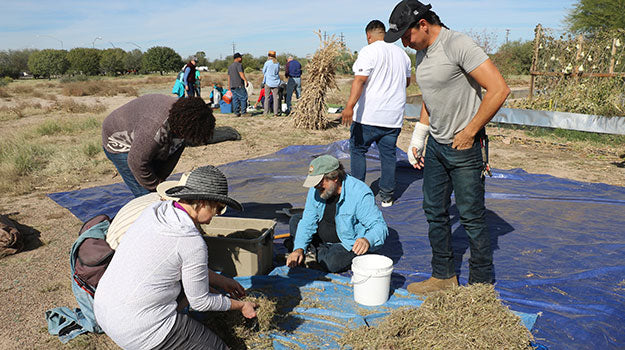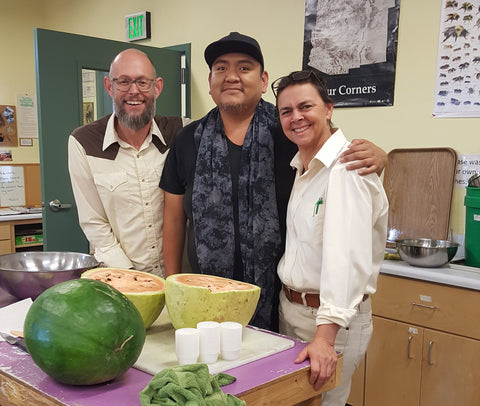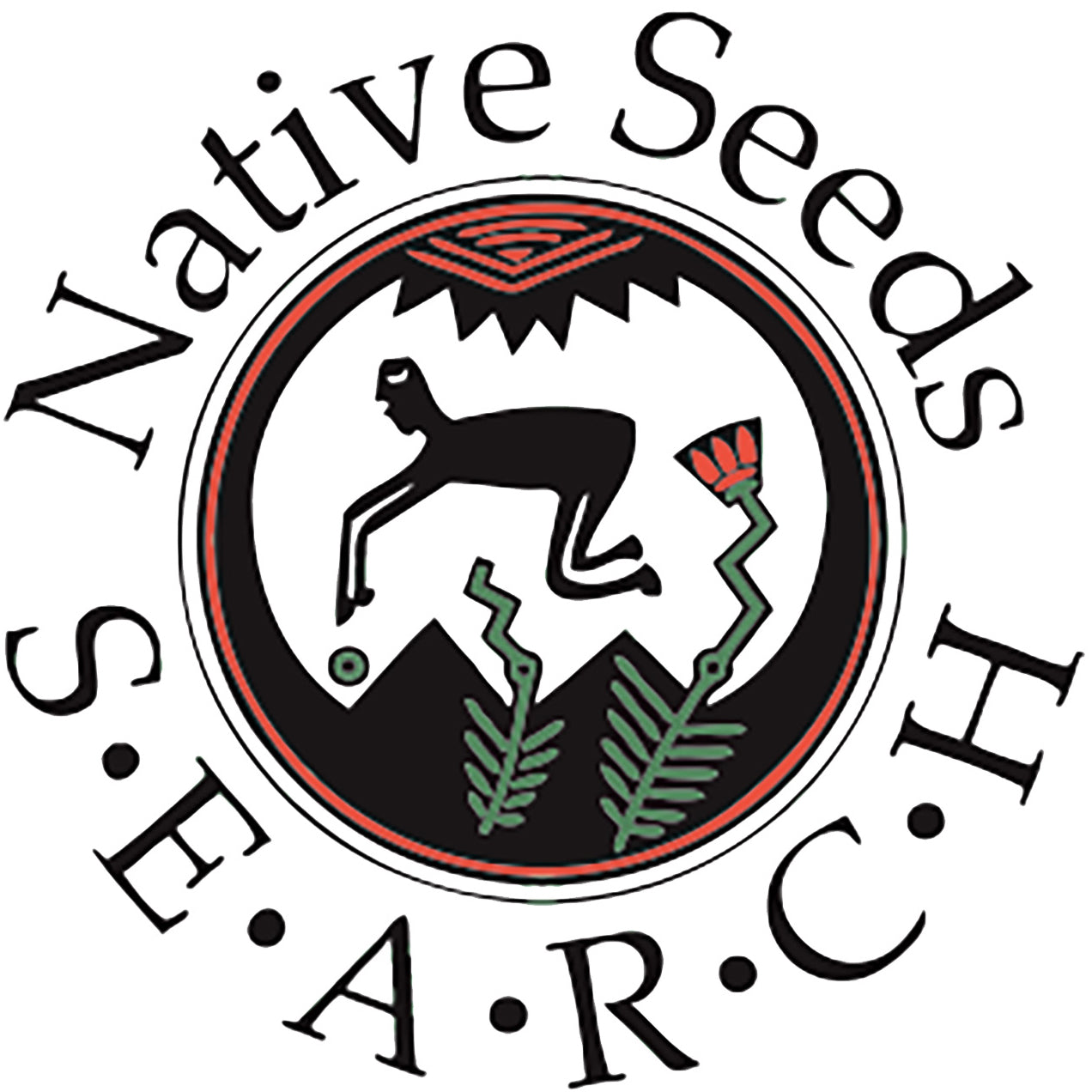
By Nicholas Garber, Conservation Program Manager.
Our Adopt-A-Crop campaign depends on our members and donors to help us cover the costs of identifying at-risk accessions; planting, growing, harvesting, and then processing seed; and preparing new long-term samples for the future of selected irreplaceable plants. For this year’s tepary bean Adopt-A-Crop, we deepened our commitment to the future of this perfect plant by partnering with farmers to grow the beans in their fields and in or near the seeds’ communities of origin. We see an agricultural future where the seeds in this collection are once again grown in fields and served at meals, and the work with farmers this season helped us to see what success really looks like even when harvests fail.
Our expanding garden at the Native Seeds/SEARCH Conservation Center in Tucson was home to the Pima Beige and Brown tepary beans. Like so much of the collection, these beans have been grown in rhythm with the natural cycles of the desert for generations. We tried to not only honor this farming tradition by planting at the start of the monsoon, but also because there is no better time to plant than when the rains have come! Tepary bean plants emerged just days after planting, and we reaped a 5-pound-harvest -- with the help of all of our stompers, stampers, and prancers who helped us thresh and winnow the pods at our Harvest Party!
Those of you who attended our harvest party also had an opportunity to meet Jon Naranjo, the farmer we partnered with to grow the Paiute Mixed Tepary bean. Jon grows in and around Santa Clara Pueblo in Northern New Mexico, and drought has hit his region hard. Many of Jon’s crops survived, but the tepary beans were under mandatory water restriction when flowering and his crop was lost. Despite this, Jon’s season still ranks as the most successful of the farmers we worked with because for the first time Jon’s teenage son worked the fields with him. All of the work Native Seeds/SEARCH does will be for nothing if we have no farmers to plant these seeds. Jon Jr. now has one challenging season under his belt, and if the delicious watermelons he shared at the harvest party are any indication, he could have a real future in farming. (Below: Cutting melon from Jon Naranjo's farm at our Harvest Party in November)
 Engaging young people in agriculture is part of the mission of Ndee Bikiyaa (The People’s Farm) at White Mountain Apache, and these kids are doing really cool things. Along with the Colonia Morelos Tepary, Shy, Leander, Onah, and Grant among others (with the supervision and support of Clayton and Emily) had a successful harvest of Apache Giant Squash, Apache Brown Stripe Sunflower, and Hopi Purple String Beans. This incredible crew celebrated their season at the 2018 Apache Harvest Festival on the farm at Canyon Day, which was a party to remember. I can still taste the acorn stew and Apache cornbread. We look forward to working more with Ndee Bikiyaa in coming seasons as these fine young students of their people’s traditional farming ways become even better and better farmers and plantspeople. (Bottom Left:Cleaning gourds at the White Mountain Apache Harvest Festival.)
Engaging young people in agriculture is part of the mission of Ndee Bikiyaa (The People’s Farm) at White Mountain Apache, and these kids are doing really cool things. Along with the Colonia Morelos Tepary, Shy, Leander, Onah, and Grant among others (with the supervision and support of Clayton and Emily) had a successful harvest of Apache Giant Squash, Apache Brown Stripe Sunflower, and Hopi Purple String Beans. This incredible crew celebrated their season at the 2018 Apache Harvest Festival on the farm at Canyon Day, which was a party to remember. I can still taste the acorn stew and Apache cornbread. We look forward to working more with Ndee Bikiyaa in coming seasons as these fine young students of their people’s traditional farming ways become even better and better farmers and plantspeople. (Bottom Left:Cleaning gourds at the White Mountain Apache Harvest Festival.)

Working with Jeremy King shows that saving the seed is only part of conserving a plant. He grew the Hopi White Tepary Bean in Pasture Canyon outside Moenkopi at Hopi, in fields that have been in cultivation for at least the last 2,000 years. In these fields Jeremy learned to farm from his grandparents, whose practices Jeremy still follows. Jeremy ‘reintroduced’ the seeds to his fields by planting a few of each in different locations. Planting sites in Jeremy’s canyon terrace fields vary with different sun and wind exposures, and -- because his fields wick water from an artesian spring for irrigation, variable water quantities. This gave us an incredible harvest of Hopi Yellow Limas, Hopi Sweet Corn, and Black Dye Sunflower, but after losing one planting to cows, our small harvest of Hopi White Tepary Beans will remain with Jeremy for replanting next year, in the perfect site he discovered this season.

Janna Anderson at Pinnacle Farms is a tractor-driving-real-deal. We have worked with Janna to grow I’itoi onions and other crops for several years now, so we wanted her to participate in our Adopt-A-Crop with the Little Tucson Brown Tepary Bean. Janna grows many market vegetables and is very knowledgeable about organic, irrigated agriculture. However, the traditional ways in which these beans were grown can make them poorly adapted to larger scale farming, ironically, because they need so much less than modern varieties. It took until September for us to find a spot where they could be properly deprived of water and celebrated Janna’s successful harvest in November!
With your support on Adopt-A-Crop 2018, we not only secured the future of five different seeds, but preserved some of their human histories, helped develop practices to scale up their production in modern systems, moved meaningful quantities back into the communities where they belong, and hope above hope inspired a few young people to undertake futures in farming. Thank you and Happy Holidays!
Special thanks to those supporters of $100 or more, we will be in touch in the New Year when we ship your adoptee’s seeds to you!
